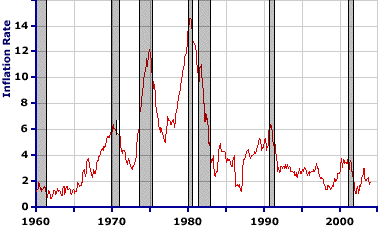
|
|
AGGREGATE DEMAND DETERMINANTS: An assortment of ceteris paribus factors that affect aggregate demand, but which are assumed constant when the aggregate demand curve is constructed. Changes in any of the aggregate demand determinants cause the aggregate demand curve to shift. While a wide variety of specific ceteris paribus factors can cause the aggregate demand curve to shift, it's usually most convenient to group them into the four, broad expenditure categories -- consumption, investment, government purchases, and net exports. The reason is that changes in these expenditures are the direct cause of shifts in the aggregate demand curve. If any determinant affects aggregate demand it MUST affect one of these four expenditures.
Visit the GLOSS*arama
|
|


|

|
                           DISINFLATION: A decline in the inflation rate. With disinflation, prices continue rising, just not as fast. Numerically speaking, disinflation occurs if the inflation rate over three consecutive years is 10 percent, 6 percent this year, and 4 percent. Disinflation, a reduction in the inflation rate, is not the same as deflation, which is an actual decline in the price level. Should disinflation continue, presumably due to anti-inflationary monetary or fiscal policies, then the average price level might eventually decline, making the transition from disinflation to deflation. | Inflation Rate |  |
Disinflation generally comes into popular use when inflation has been relatively high and troublesome for a period of time and people are looking for any sign of relief. As such, a decrease in the inflation rate is taken as good news. However, disinflation is actually a relatively common phenomenon associated with business cycles. As this chart of inflation rates over the past few decades illustrates, inflation invariably declines during business-cycle contractions (shaded areas).During the contraction of the early 1990s, disinflation brought the inflation rate down from about 6 percent to just over 2 percent. An even more dramatic example of disinflation resulted from the contraction of the early 1980s. The inflation rate declined from over 14 percent to under 4 percent. In fact, this particular contraction was created with contractionary monetary policy by the Federal Reserve System with the expressed goal of reducing the high inflation rates that characterized the 1970s, that is, to achieve disinflation.

Recommended Citation:DISINFLATION, AmosWEB Encyclonomic WEB*pedia, http://www.AmosWEB.com, AmosWEB LLC, 2000-2025. [Accessed: July 1, 2025].
Check Out These Related Terms... | | | | | | | | | | |
Or For A Little Background... | | | | | | | | | |
And For Further Study... | | | | | | | | | | | | | |
Related Websites (Will Open in New Window)... | | |
Search Again?
Back to the WEB*pedia
|



|

|
GRAY SKITTERY
[What's This?]
Today, you are likely to spend a great deal of time at a flea market hoping to buy either an ink cartridge for your printer or a rechargeable battery for your camera. Be on the lookout for the happiest person in the room.
Your Complete Scope
This isn't me! What am I?
|

|
|
Before 1933, the U.S. dime was legal as payment only in transactions of $10 or less.
|

|
|
"Experience keeps a dear school, but fools will learn in no other. " -- Benjamin Franklin
|

|
AFA
Advertising Federation of America
|

|
|
Tell us what you think about AmosWEB. Like what you see? Have suggestions for improvements? Let us know. Click the User Feedback link.
User Feedback
|


|


